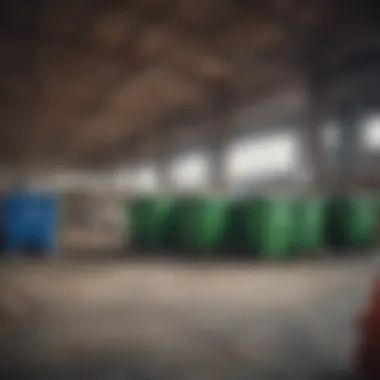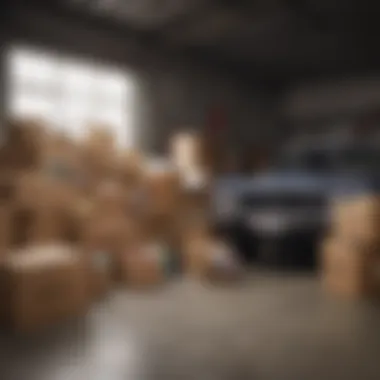Where to Drop Off Junk: Your Guide to Responsible Disposal


Intro
Disposing of junk is a reality everyone faces. Whether it’s old furniture, electronics, or general clutter, knowing where and how to drop off this junk is critical for both personal efficiency and environmental sustainability. This article will dive into the various options available for responsible junk disposal while emphasizing the significance of effective waste management.
Overview of the Topic
Proper junk disposal intersects with environmental conservation and personal responsibility. Growing urbanization and consumerism have led to heaps of waste that detrimental impact the planet. As a responsible citizen and proactive member of your community, understanding the options for discarding unwanted materials is essential. The rising trends in recycling initiatives highlight the imperative for more sustainable waste practices.
A comprehensive understanding of the landscape of junk disposal not only aids individual actions but also contributes to broader resource conservation efforts. This includes examining every segment from personal trash to large scale municipal waste and how each component interacts within the larger ecosystem.')
Current Status and Challenges
Today, the landscape of junk disposal presents both clarity and complexity. Municipal drop-off sites, landfills, recycling centers, and various private disposal services exist at diverse levels of operational capability. Despite these options, critical challenges remain.
- Limited Awareness: Many people aren’t familiar with what can and cannot be recycled, leading to improper disposal methods.
- Container Overflows: The volume of junk often outstrips available processing capability, resulting in environmental degradation when junk is illegally dumped.
- Cost Barriers: Some disposal services charge fees, making waste management a burden for low-income communities.
These challenges create significant barriers and necessitate robust strategies to enhance available and effective junk disposal options.
Sustainable Solutions
By identifying and embracing sustainable practices, individuals and communities can more effectively handle junk. Below are some explored solutions that yield positive environmental impacts:
- Local Recycling Programs: Engaging with Municipality-recommended programs ensures that metals, plastics, and paper products are disposed of effectively.
- Charitable Organizations: Donating furniture and clothing reduces landfill rates while providing resources to those in need.
- Composting Initiatives: For organic waste, composting transforms scraps into rich mulch that benefits soil health.
Successful case studies show how towns and cities implementing these solutions can significantly reduce their overall waste production. Noteworthy examples include San Francisco’s zero waste initiative, aiming for 100% diversion of waste from landfills by 2030.
Impact and Importance
Understanding the connotations of disposing of junk extends beyond immediate relief from clutter. Following best practices contributes positively towards ecosystems and public health over time.
Understanding Junk Disposal
In today’s world, effective junk disposal has become crucial. The topic, Understanding Junk Disposal, underscores the significant implications it has for our environment and community well-being. The surge in consumerism has produced vast quantities of waste. Thus, how one disposes of junk must be a thoughtful act, reflecting responsibility towards resource management. When individuals understand the landscape of junk disposal, they are not merely checking off a chore but actively participating in preserving vital resources. Responsible junk disposal promotes recycling, reduces landfill waste, and encourages a circular economy.
Definition of Junk
Junk can be defined as items that are no longer useful or wanted. It often includes various categories like furniture, appliances, clothing, and electronic waste. Each of these items, once discarded, presents different challenges and considerations for disposal. For instance, bulky items such as sofas and refrigerators typically require different handling compared to smaller household waste or e-waste. Milestones in defining junk also involve understanding its potential for reuse or recycling, emphasizing that what is deemed junk could still hold value in another context.
Importance of Responsible Disposal
Responsible junk disposal holds significant value far beyond simple cleanliness. It influences environmental impact, health risks, and community aesthetics. Here are a few key points regarding responsible disposal:
- Environmental Benefits: Reducing landfill overflow contributes to better land quality and prevents pollution of water resources.
- Health Risks Mitigation: Improper disposal, especially of hazardous materials like batteries or chemicals, can pose serious health risks to communities.
- Social Responsibility: Many hardworking organizations depend on donations of usable goods. Diverting such items from landfills provides community support and decreases waste.
“Each aspect of responsible junk disposal enriches our life and environment, offering simpler solutions to waste management.”
Types of Junk
Understanding the various types of junk is essential for responsible disposal. Each type comes with its own challenges and right methods for disposal, thus affecting waste management. Knowing these different categories helps in efficiently segregating items and deciding in what manner to part with them. This section delves into the specifics of household junk, electronic waste, and construction debris, illustrating not only what constitutes these categories but also their significance in today’s environmentally conscious world.
Household Junk


Household junk encompasses a wide variety of items. This category includes furniture, appliances, clothing, and various household items one no longer needs. When dealing with household junk, it is important to recognize that these items can vary in their potential for recycling or reuse.
Many items in this category, such as books or gently used clothing, hold resale value. Therefore, one could donate them or sell on platforms like Facebook Marketplace or eBay. Additionally, furniture and appliances can often be refurbished.
Many municipalities host jumble sale-style drop-offs, contributing to community interaction and promoting a culture of reuse rather than trashing these items immediately.
*Considerable points for household junk:
- Assess the condition of the item's design to decide whether it can be wrecked down for new use.
- Check local charity organizations that might take usable items.*
Electronic Waste
Electronic waste refers to modern gadgets and appliances that are no longer functional or relevant. This category covers items like computers, phones, televisions, and kitchen electronics, such as toasters or microwaves. The disposal of electronic waste is particularly vital because such items often contain hazardous materials that can harm the environment if they are disposed of irresponsibly.
It is crucial to find designated e-waste recycling facilities, as they are well-equipped to handle these materials safely. Many cities provide specified collection days or drop-off centers specifically for electronic waste, promoting responsible handling as well as providing confidential recycling processes to safeguard personal data.
Drop-off Locations for Junk
Drop-off locations for junk play a critical role in responsible waste management and environmental sustainability. Having a variety of options allows residents to easily and safely dispose of their unwanted items. This segment covers specific types of facilities typically designated for junk disposal, each with unique operational principles and areas of focus. Selecting the appropriate drop-off location can facilitate a streamlined disposal process while aligning with community standards and environmental regulations.
Local Waste Management Facilities
Local waste management facilities serve as primary points for disposing of various types of junk. These facilities are often operated by municipal governments and are designed to handle a wide array of waste from residents.
Visiting a local waste management facility provides good advantages. Firstly, they maintain regulated operations, ensuring that wastes are processed according to environmental standards. They typically offer a convenient location where individuals can drop off items like bulky waste, furniture, and yard debris. These facilities usually have set hours of operation, and residents may also use them without reservations.
Considerations include understanding what types of materials are accepted. For example, some facilities may not accept electronic waste, requiring an alternative site to discard that item.
Community Recycling Centers
Community recycling centers contribute to sustainable waste management by promoting recycling of materials that might otherwise be thrown away. These centers allow individuals to bring in recyclable materials like paper, plastics, glass, and metal.
Benefits of using community recycling centers include:
- Encouraging eco-friendly practices - These centers aim to minimize trash sent to landfills by offering a place for valuable materials to be processed and ultimately reused.
- Education and awareness - Community centers often engage in educational outreach, teaching citizens about the importance of recycling and waste reduction.
- Convenience - Many are built with user-friendly systems, enabling quick drop-offs and easy sorting.
It is important to check their guidelines before visiting. Specific items such as broken glass or electronics could require special handling processes.
Donation Centers for Usable Items
Donation centers for usable items provide an excellent alternative to traditional junk disposal. Many non-profit organizations accept second-hand goods, ensuring that items in good condition can find new homes rather than ending up in landfills.
For instance, organizations like Goodwill and Salvation Army are common choices for donation. They accept a wide range of household goods, including clothing, appliances, and furniture.
Using donation centers helps in several ways:
- Social benefit - Donated items can support community programs or individuals in need.
- Tax deductions - In some instances, making charitable donations can be tax-deductible, providing financial incentives for the contributor.
Nonetheless, potential donators should ensure their items meet the acceptance criteria set by the specific organization to avoid any inconvenience.
Hazardous Waste Disposal Sites
Disposing of hazardous waste requires specialized care to prevent harm to human health and the environment. This category includes materials like chemicals, batteries, and paints any of which can be detrimental if not handled properly. Hazardous waste disposal sites are specifically tailored for this purpose.


These locations often have stricter regulations and assessment criteria, including:
- Safe containment methods - Proper handling of toxic substances ensures safety for the community and the environment.
- Controlled drop-off schedules - Many hazardous waste facilities permit drop-offs only during designated collection days.
Awareness of these requirements is crucial for ensuring regulatory compliance and protecting public health. Information commonly posted on community or state government websites can assist in locating nearby hazardous waste disposal sites.
Steps to Prepare for Drop-off
Preparation is crucial when you plan to take unwanted items for disposal. Adequate preparation helps streamline the process and ensures that everything is handled responsibly. Clear steps encourage individuals to think about what exactly they are discarding and why, fostering a mindset geared towards sustainable waste management. Understanding what needs to be done aids in reducing time spent at the drop-off locations and ensures compliance with applicable regulations. This article examines three key areas to focus on when preparing for junk disposal: sorting your junk, safe handling of hazardous materials, and proper packaging and transportation.
Sorting Your Junk
Sorting your junk is the first step to ensure efficient drop-off. Items should be separated based on their type and condition. Different materials require different disposal methods, and many – like metal and plastic – can often be recycled. Household junk, such as old furniture or broken appliances, must be distinguished from recyclable materials. While sorting, consider making piles for:
- Reusable items
- Recyclable materials
- Trash
- Hazardous waste
This categorization boosts efficiency and enhances the recyclability of materials.
Safe Handling of Hazardous Materials
Handling hazardous materials requires special care. Many household items contain dangerous chemicals that can harm the environment if discarded improperly. Examples include paint, batteries, electronics, and cleaning supplies. It’s essential to consult local regulations about the proper disposal of such items. Ensure you wear protective gear, such as gloves and masks, when handling these materials to avoid any potential health risks. Keep these items separate from other junk to simplify the disposal process.
Packaging and Transportation
Once sorting is completed and hazardous materials handled, the next step is packaging items for transportation. Use secure and well-labeled containers for transport. This prevents leaks and spills during the journey. Consider the following tips:
- Label containers clearly to indicate whether contents are recyclable or hazardous.
- Use durable bags or boxes to prevent items from breaking.
- Avoid overloading your vehicle. Ensure everything is safely stored to prevent accidents on the road.
Following these steps allows for a smooth drop-off process. Taking the time to prepare thoroughly not only promotes individual responsibility but also sets a precedent for community practices in waste management.
"Preparation is the key to success in managing junk disposal efficiently."
By embracing these preparatory steps, individuals contribute positively to their environments, ultimately leading to a healthier ecosystem.
Legal Considerations in Junk Disposal
Understanding the legal aspects of junk disposal is essential for anyone looking to get rid of unwanted items properly. Recycling, disposing, or donating junk is not just an act of decluttering but also has legal ramifications. Failing to adhere to local ordinances and regulations can lead to unwanted fines or legal issues. Therefore, it's vital to know the laws that govern waste disposal in your area, as these laws are designed to protect both individuals and the environment.
Local Ordinances and Regulations
Each municipality has its regulations associated with waste disposal. Local ordinances can dictate how, when, and where you may dispose of junk. These rules can vary significantly depending on the region.
Consider these
- Collection Days: Knowing scheduled bulk collection days is important to avoid fines for leaving junk on the curb.
- Permitted Designations: Some areas require special permits for large item pickups or specific disposal methods.
- Penalties: Understanding the consequences of improper disposal helps avoid hefty fines which can be more than what one might think.
When in doubt, residents should consult their local government websites or contact local waste management facilities to ensure compliance. Staying informed protects you from missteps that could lead to legal complications.
Environmental Protection Laws
Beyond local ordinances, environmental protection laws also play a critical role in junk disposal. These laws are designed to protect public health and safeguard natural resources.


It includes regulations regarding
- Hazardous Waste: Certain items, like chemicals and batteries, must be disposed of following strict protocols to prevent environmental damage.
- Recycling Requirements: Many states have laws that require specific materials to be recycled to reduce landfill use. Ignoring such laws can have wide-reaching effects on community efforts in conservation.
- Liability Concerns: Individuals may be held responsible for any harm caused by improper disposal, creating a need to stay compliant with environmental legislation.
Understanding local and environmental laws ensures responsible junk disposal while safeguarding public and environmental health.
For activists, conservationists, and anyone focused on environmental issues, navigating legal facets of junk disposal cannot be overlooked. This awareness helps in actively participating in sustainable waste management practices.
Alternative Junk Disposal Options
Alternative junk disposal options are essential for individuals seeking responsible ways to manage their unwanted items. Beyond the conventional drop-off approaches, alternative methods provide flexibility, convenience, and potential benefits for both the individual and the environment.
Two primary alternative options exist here: junk removal services and selling unwanted items. Each option presents distinct advantages and considerations which promote sustainable consumption.
Junk Removal Services
Junk removal services offer a practical solution for individuals who may not have the means or time to transport their junk themselves. These providers specialize in efficiently removing a variety of items, from old furniture to large appliances. In addition to saving time and energy, this service also ensures that unwanted items are handled appropriately.
Key aspects of using junk removal services include:
- Efficiency: Professionals are trained to handle bulky and awkward items, streamlining the removal process.
- Safety: Doing it yourself can lead to accidents, especially with heavy items or hazardous materials. Hiring experts mitigates these risks.
- Responsible Disposal: Most junk removal companies practice eco-friendly disposal methods. Some items may be recycled, reducing landfill contributions.
However, users must consider the costs involved. Service fees may vary, prompting some to obtain quotes from different providers. Evaluating waste types allows individuals to choose services that specialize in certain items if necessary.
Selling Unwanted Items
Alternative routes for people involve selling unwanted items. Platforms like Craigslist, Facebook Marketplace, and eBay enable individuals to connect with potential buyers directly. This process extends the lifespan of usable items, reducing waste while introducing an element of financial gain.
Advantages of selling include:
- Revenue Generation: Unused items can translate into cash, offering an immediate benefit to sellers.
- Sustainability: By finding new homes for items, individuals contribute to resource conservation and sustainability efforts.
- Local Economy Boost: Selling items locally helps strengthen community ties and promotes local businesses.
Despite these positives, selling unwanted items requires effort. It may involve taking photographs, writing detailed descriptions, and managing potential buyers. Patience is also necessary, as selling can take time.
Overall, considering alternative junk disposal options not only influences personal decision-making but also contributes to larger environmental goals. The benefits highlight the importance of responsible actions in contemporary waste management.
"Taking charge of unwanted items is not just a personal benefit; it extends into significant ecological impacts."
Engaging in these behaviors reflects a commitment to environmental sustainability and greater resource utilization.
Finale
The discussion on where to drop off junk is vital in promoting responsible waste management. Understanding the options available allows individuals to make informed decisions about how to dispose of their unwanted items while considering the environmental impacts.
Summary of Options
There are several avenues one can pursue for junk disposal:\n
- Local Waste Management Facilities: These centers typically accept a wide range of junk, from household items to construction debris, providing an essential service for clearing waste responsibly.
- Community Recycling Centers: These locations focus on recycling materials rather than disposal. Properly sorting recyclables is necessary to make effective use of these centers.
- Donation Centers for Usable Items: Not everything needs to go to waste. Donation centers like Goodwill or Salvation Army accept furniture, clothing, and appliances that are still in good condition, allowing items to find new homes.
- Hazardous Waste Disposal Sites: Residents can dispose of items containing chemicals, electronics, or substances deemed hazardous at these specialized sites to mitigate health risks and environmental pollution.
- Junk Removal Services: For large volumes of junk or for those who need help, junk removal companies can provide efficient solutions, ultimately saving time and ensuring proper disposal practices.
Encouragement for Responsibly Managing Junk
Responsible management of junk extends beyond simply dropping items off at a specific location. It involves a thoughtful approach to what to keep, what to recycle, and what to ensure ends up in a landfill. Educating oneself about the effects of waste on the environment promotes better practices.
Involving community efforts like neighborhood clean-up days, sharing information on local recycling events, or creating recycling education initiatives can foster a more sustainable mindset.
"By consciously prioritizing responsible disposal methods, each person can contribute uniquey to a collective effort leading toward less trash in our landfills and a healthier environment for all."
Overall, it’s important to recognize that even small efforts can significantly impact environmental conservation. Each act of mindful disposal reduces potential harm to the planet while promoting a culture of sustainability and recycling within communities.



